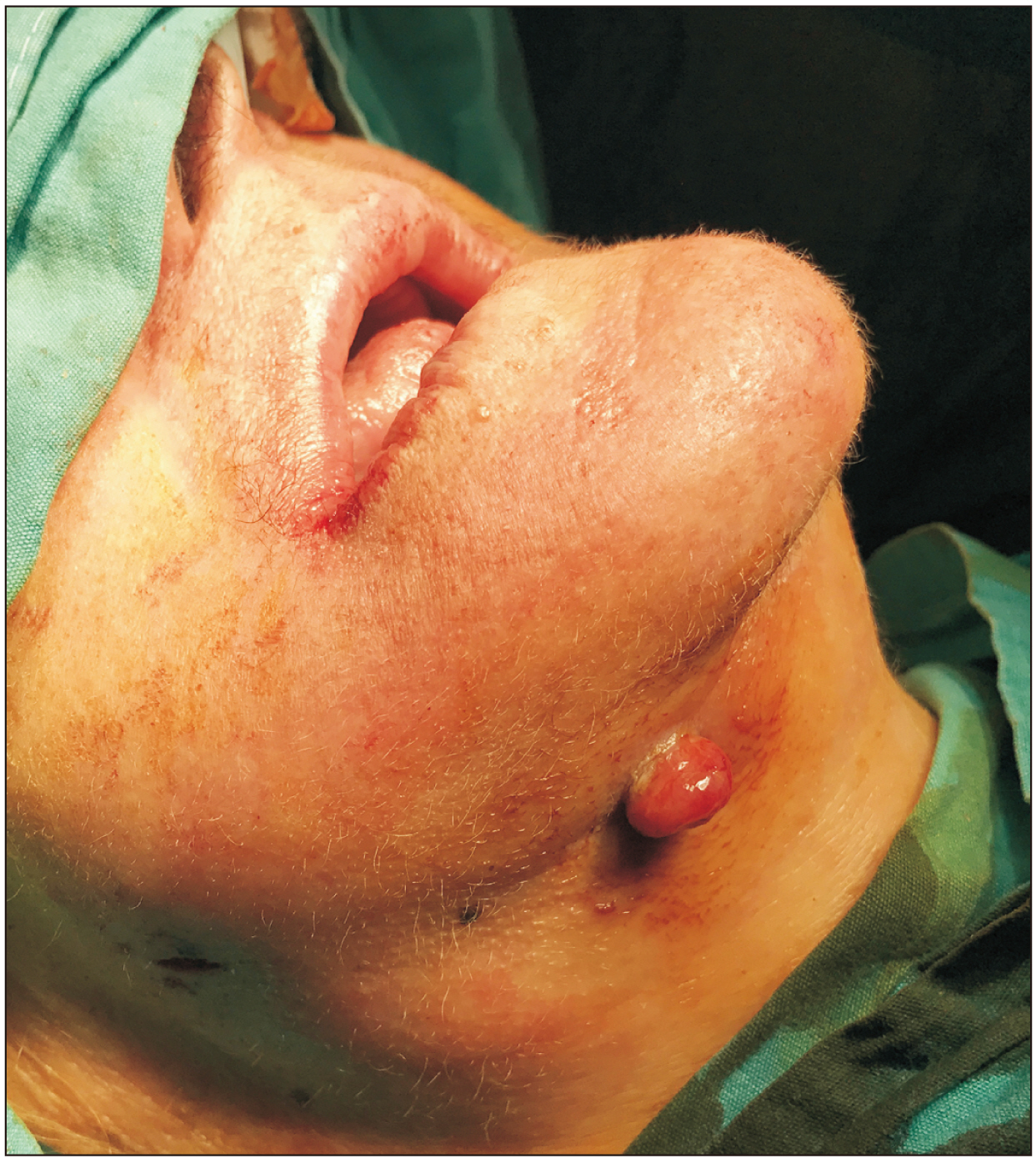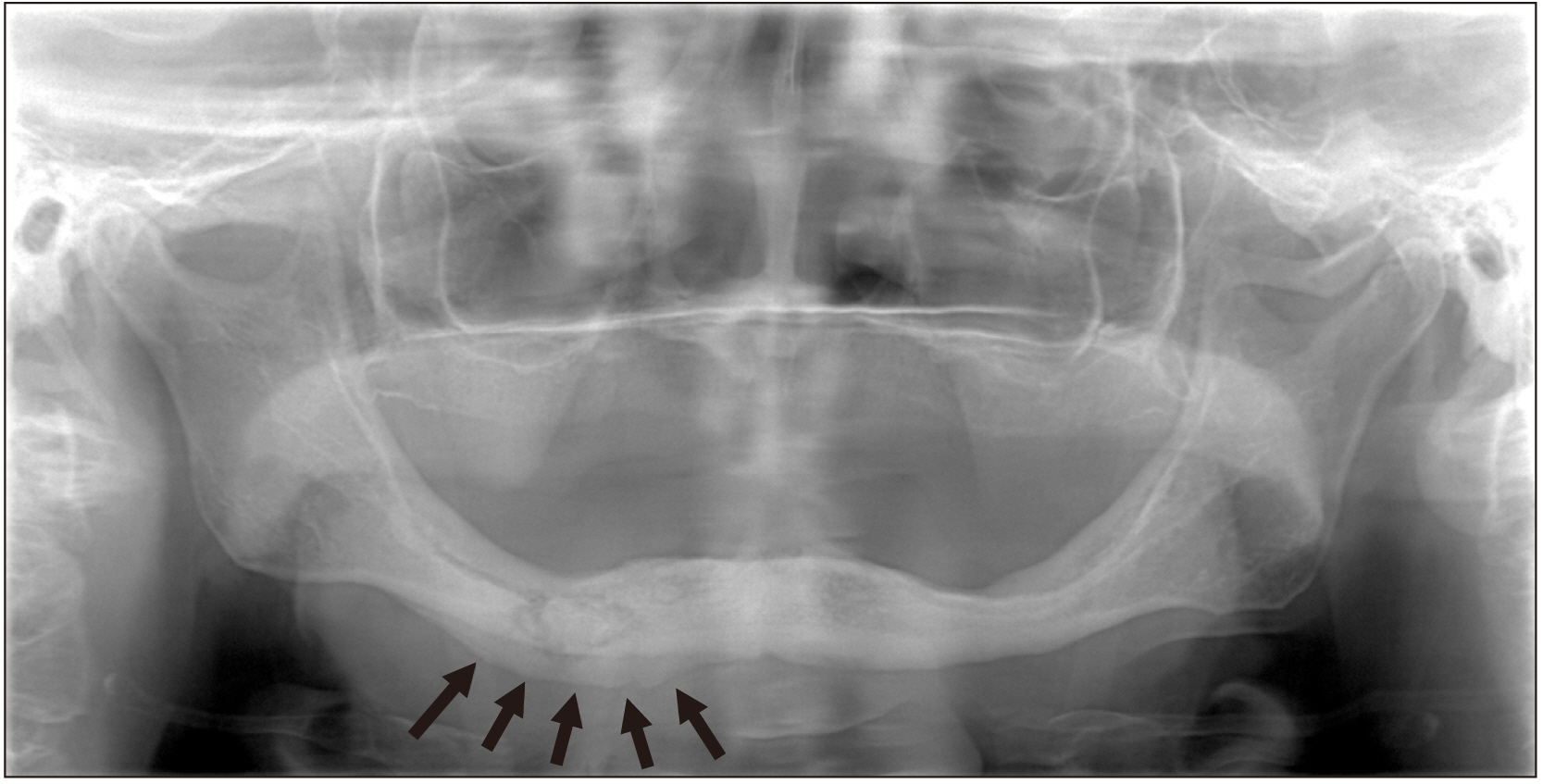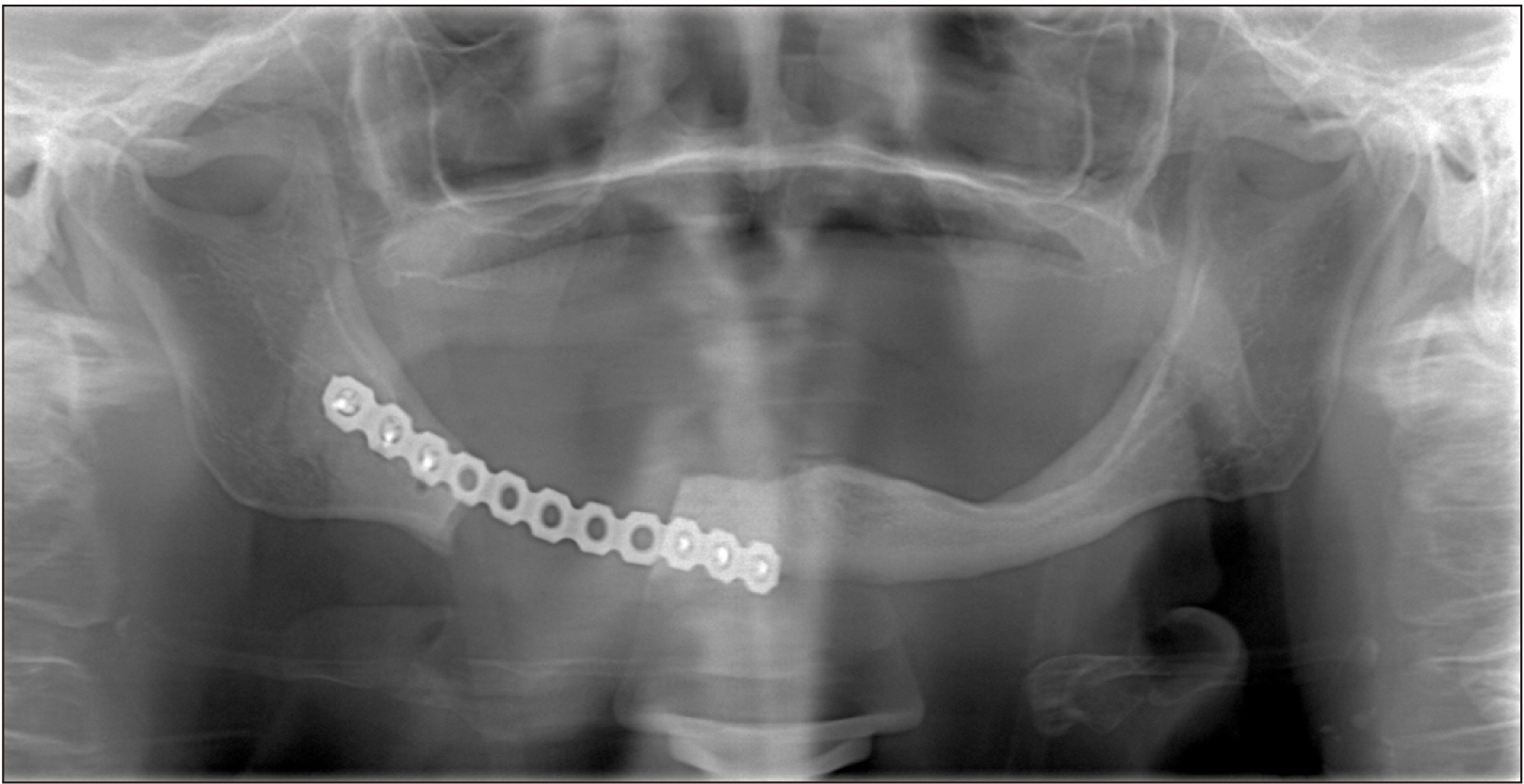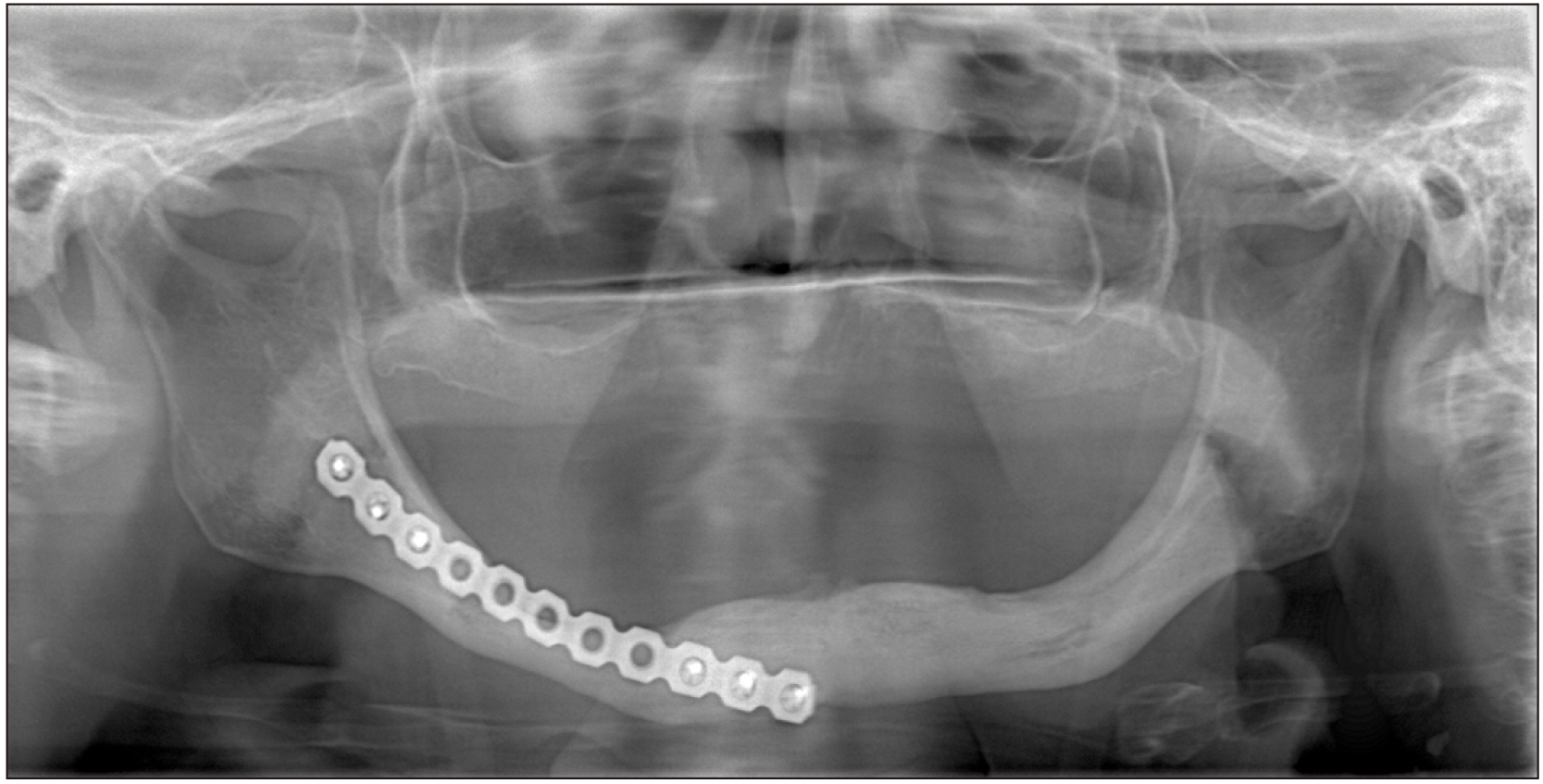J Korean Assoc Oral Maxillofac Surg.
2021 Dec;47(6):465-470. 10.5125/jkaoms.2021.47.6.465.
Spontaneous bone regeneration in resected non-continuous mandible due to medication-related osteonecrosis of the jaw
- Affiliations
-
- 1Department of Oral and Maxillofacial Surgery, Faculty of Dentistry, Necmettin Erbakan University, Konya, Turkey
- 2Department of Oral and Maxillofacial Surgery, Faculty of Dentistry, Selcuk University, Konya, Turkey
- KMID: 2524706
- DOI: http://doi.org/10.5125/jkaoms.2021.47.6.465
Abstract
- Few cases of spontaneous bone regeneration after extensive resection of the jaw bone have been reported, but it is more common in young adults or children. In this case, we report spontaneous bone healing in a 73-year-old female patient. On radiological examination, necrotic regions were seen in the right mandible. She was diagnosed with medication-related osteonecrosis of the jaw due to previous bisphosphonate use. After segmental resection, stabilization achieved using a reconstruction plate. The periosteum was preserved during the procedure. Twelve months later, panoramic radiography was taken and bone formation was seen both horizontally and vertically around the plate. If the periosteum is preserved and stabilization is achieved after resection in benign lesions, the bone may regenerate spontaneously regardless of age. Therefore, instead of simultaneous autogenous bone application, such patients may be followed to determine whether spontaneous bone healing will occur. This should improve patient comfort and reduce surgical cost.
Keyword
Figure
Reference
-
References
1. Ruggiero SL, Dodson TB, Fantasia J, Goodday R, Aghaloo T, Mehrotra B, et al. 2014; ; American Association of Oral and Maxillofacial Surgeons. American Association of Oral and Maxillofacial Surgeons position paper on medication-related osteonecrosis of the jaw--2014 update. J Oral Maxillofac Surg. 72:1938–56. https://doi.org/10.1016/j.joms.2014.04.031. DOI: 10.1016/j.joms.2014.04.031. PMID: 25234529.
Article2. Reid IR, Bolland MJ, Grey AB. 2007; Is bisphosphonate-associated osteonecrosis of the jaw caused by soft tissue toxicity? Bone. 41:318–20. https://doi.org/10.1016/j.bone.2007.04.196. DOI: 10.1016/j.bone.2007.04.196. PMID: 17572168.
Article3. Kazanjian VH. 1946; Spontaneous regeneration of bone following excision of section of the mandible. Am J Orthod Oral Surg. 32:242–8. https://doi.org/10.1016/0096-6347(46)90016-6. DOI: 10.1016/0096-6347(46)90016-6.
Article4. Kisner WH. 1980; Spontaneous posttraumatic mandibular regeneration. Plast Reconstr Surg. 66:442–7. DOI: 10.1097/00006534-198066030-00023. PMID: 7422730.
Article5. Boyne PJ. 1983; The restoration of resected mandibles in children without the use of bone grafts. Head Neck Surg. 6:626–31. https://doi.org/10.1002/hed.2890060203. DOI: 10.1002/hed.2890060203. PMID: 6358132.
Article6. Shuker S. 1985; Spontaneous regeneration of the mandible in a child. A sequel to partial avulsion as a result of a war injury. J Maxillofac Surg. 13:70–3. https://doi.org/10.1016/s0301-0503(85)80019-9. DOI: 10.1016/S0301-0503(85)80019-9.
Article7. Anyanechi CE, Saheeb BD, Bassey GO. 2016; Spontaneous bone regeneration after segmental mandibular resection: a retrospective study of 13 cases. Int J Oral Maxillofac Surg. 45:1268–72. https://doi.org/10.1016/j.ijom.2016.04.011. DOI: 10.1016/j.ijom.2016.04.011. PMID: 27138240.
Article8. Ruggiero SL, Donoff RB. 1991; Bone regeneration after mandibular resection: report of two cases. J Oral Maxillofac Surg. 49:647–52. https://doi.org/10.1016/0278-2391(91)90349-q. DOI: 10.1016/0278-2391(91)90349-Q.
Article9. McKibbin B. 1978; The biology of fracture healing in long bones. J Bone Joint Surg Br. 60-B:150–62. https://doi.org/10.1302/0301-620X.60B2.350882. DOI: 10.1302/0301-620X.60B2.350882. PMID: 350882.
Article10. Einhorn TA. 1998; The cell and molecular biology of fracture healing. Clin Orthop Relat Res. (355 Suppl):S7–21. https://doi.org/10.1097/00003086-199810001-00003. DOI: 10.1097/00003086-199810001-00003. PMID: 9917622.
Article11. Li Z, Pan J, Ma J, Zhang Z, Bai Y. 2017; Microarray gene expression of periosteum in spontaneous bone regeneration of mandibular segmental defects. Sci Rep. 7:13535. https://doi.org/10.1038/s41598-017-13586-8. DOI: 10.1038/s41598-017-13586-8. PMID: 29051537. PMCID: PMC5648814.
Article12. Julien A, Abou-Khalil R, Frangi G, Carvalho C, Cagnard N, et al. Duchamp de Lageneste O. 2018; Periosteum contains skeletal stem cells with high bone regenerative potential controlled by Periostin. Nat Commun. 9:773. https://doi.org/10.1038/s41467-018-03124-z. DOI: 10.1038/s41467-018-03124-z. PMID: 29472541. PMCID: PMC5823889.
Article13. de Villa GH, Chen CT, Chen YR. 2003; Spontaneous bone regeneration of the mandible in an elderly patient: a case report and review of the literature. Chang Gung Med J. 26:363–9.14. Marx RE, Tursun R. 2012; Suppurative osteomyelitis, bisphosphonate induced osteonecrosis, osteoradionecrosis: a blinded histopathologic comparison and its implications for the mechanism of each disease. Int J Oral Maxillofac Surg. 41:283–9. https://doi.org/10.1016/j.ijom.2011.12.016. DOI: 10.1016/j.ijom.2011.12.016. PMID: 22244079.
Article15. Qaisi M, Montague L. 2017; Bone margin analysis for osteonecrosis and osteomyelitis of the jaws. Oral Maxillofac Surg Clin North Am. 29:301–13. https://doi.org/10.1016/j.coms.2017.03.007. DOI: 10.1016/j.coms.2017.03.007. PMID: 28709531.
Article16. Elbeshir EI. 1990; Spontaneous regeneration of the mandibular bone following hemimandibulectomy. Br J Oral Maxillofac Surg. 28:128–30. https://doi.org/10.1016/0266-4356(90)90140-g. DOI: 10.1016/0266-4356(90)90140-G.
Article17. Zhang Z, Hu J, Ma J, Pan J. 2015; Spontaneous regeneration of bone after removal of a vascularised fibular bone graft from a mandibular segmental defect: a case report. Br J Oral Maxillofac Surg. 53:650–1. https://doi.org/10.1016/j.bjoms.2015.04.002. DOI: 10.1016/j.bjoms.2015.04.002. PMID: 25960023.
Article18. Abdulai AE. 2012; Complete spontaneous bone regeneration following partial mandibulectomy. Ghana Med J. 46:174–7.19. Okoturo E, Ogunbanjo OV, Arotiba GT. 2016; Spontaneous regeneration of the mandible: an institutional audit of regenerated bone and osteocompetent periosteum. J Oral Maxillofac Surg. 74:1660–7. https://doi.org/10.1016/j.joms.2016.02.007. DOI: 10.1016/j.joms.2016.02.007. PMID: 26970145.
Article20. Goh BT, Lee S, Tideman H, Stoelinga PJ. 2008; Mandibular reconstruction in adults: a review. Int J Oral Maxillofac Surg. 37:597–605. https://doi.org/10.1016/j.ijom.2008.03.002. DOI: 10.1016/j.ijom.2008.03.002. PMID: 18450424.
Article
- Full Text Links
- Actions
-
Cited
- CITED
-
- Close
- Share
- Similar articles
-
- Multidisciplinary approach for medication-related osteonecrosis of the jaws: a case report and literature review
- A critical assessment of the medication-related osteonecrosis of the jaw classification in stage I patients: a retrospective analysis
- A case of bisphosphonate-related osteonecrosis of the jaw with a particularly unfavourable course: a case report
- Teriparatide therapy without surgical treatment for medication-related osteonecrosis of the jaw: a report of two cases
- A Case of Intravenous Pamidronate-Related Osteonecrosis of the Jaw in a Patient with Waldenstrom's Macroglobulinemia





